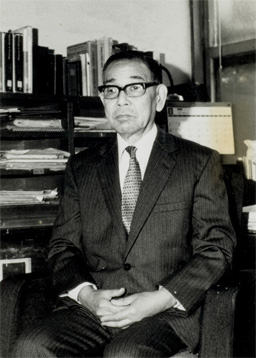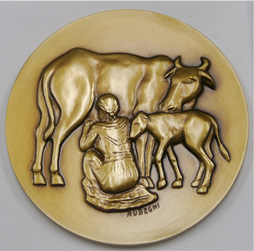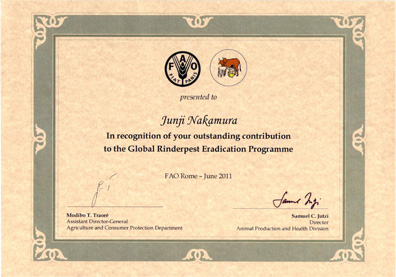- Top
- Background
Junji Nakamura
Predecessor of NISSEIKEN, Nippon Institute for Biological Science, Incorporated Association was founded in 1947 by Junji Nakamura. His contribution toward developing vaccines for rinderpest led to the total eradication of that viral infectious disease. Many awards he received tell us the magnitude of his achievements.

Personal background
- 1903
- Born in Osaka City
- 1926
- Graduated from the Department of Veterinary Medicine, College of Agriculture, Tokyo Imperial University
- 1941
- Received a Doctor of Agriculture
- 1947
- Founded the Nippon Institute for Biological Science, Incorporated Association
- 1950
- Assumed the post of Director of the Nippon Institute for Biological Science
- 1955
- Received an award from the Ministry of Agriculture and Forestry for the creation of a lapinized-avianized virus
- 1965
- Received the Medal with Purple Ribbon (development of rinderpest vaccines)
- 1970
- Received an award from the Science and Technology Agency for the development of a method for purification of the Japanese encephalitis vaccine
- 1972
- Received the Order of the Sacred Treasure, Gold Rays with Neck Ribbon (recognition of the development of a lapinized rinderpest virus vaccine)
- 1975
- Passed away
- 2011
- The eradication of rinderpest was declared at the General Assembly of the Food and Agriculture Organization (FAO: Rome). A certificate of appreciation was sent to Dr. Junji Nakamura, who made considerable contribution to the development of rinderpest vaccines, and vaccination/eradication programs for the disease.
Achievements
On June 28, 2011, the eradication of rinderpest was declared at the General Assembly of FAO held in Rome. This indicates that the disease is the second viral infectious disease to have been eradicated after smallpox in human beings. Rinderpest is currently little known because it was eradicated in Japan in 1922. However, it had inflicted catastrophic damage on cattle, an important work force in agriculture, throughout the ages. Thus, rinderpest is an acute viral infectious disease of cattle that had shaken the world.

(Medal Dr. Nakamura was awarded for his achievements)
Many Japanese scientists had contributed to the eradication of rinderpest, including the development of the early vaccines. The first rinderpest vaccine in the world was the inactivated vaccine developed by Dr. Chiharu Kagizaki at the Rinderpest Serum Laboratory of the General Headquarters of Korea in Busan in 1918. Subsequently, Dr. Junji Nakamura, who was investigating the pathogenic mechanism of rinderpest with rabbits at the laboratory, noticed that the virus had been attenuated after 100 passages. In 1942, he presented the 300th passage virus in rabbit as a live attenuated vaccine (L vaccine: L stands for lapinized).

(Certificate of appreciation Dr. Nakamura received)
After the end of World War II, Dr. Junji Nakamura further developed a live attenuated vaccine acclimatized to chick embryo (lapinized avianized [LA] vaccine) at the Nippon Institute for Biological Science. This vaccine could be used without immune serum that was concomitantly used to prevent adverse reactions to the L vaccine. With the LA vaccine, the eradication of rinderpest had been almost achieved by the 1960s in Asia excluding India and Pakistan. At the General Assembly of FAO held in Rome in June 2011, the certificates of appreciation and medals were awarded to Dr. Junji Nakamura and others for their significant contribution to the eradication of rinderpest through the development of vaccines, instruction of vaccination, etc.

